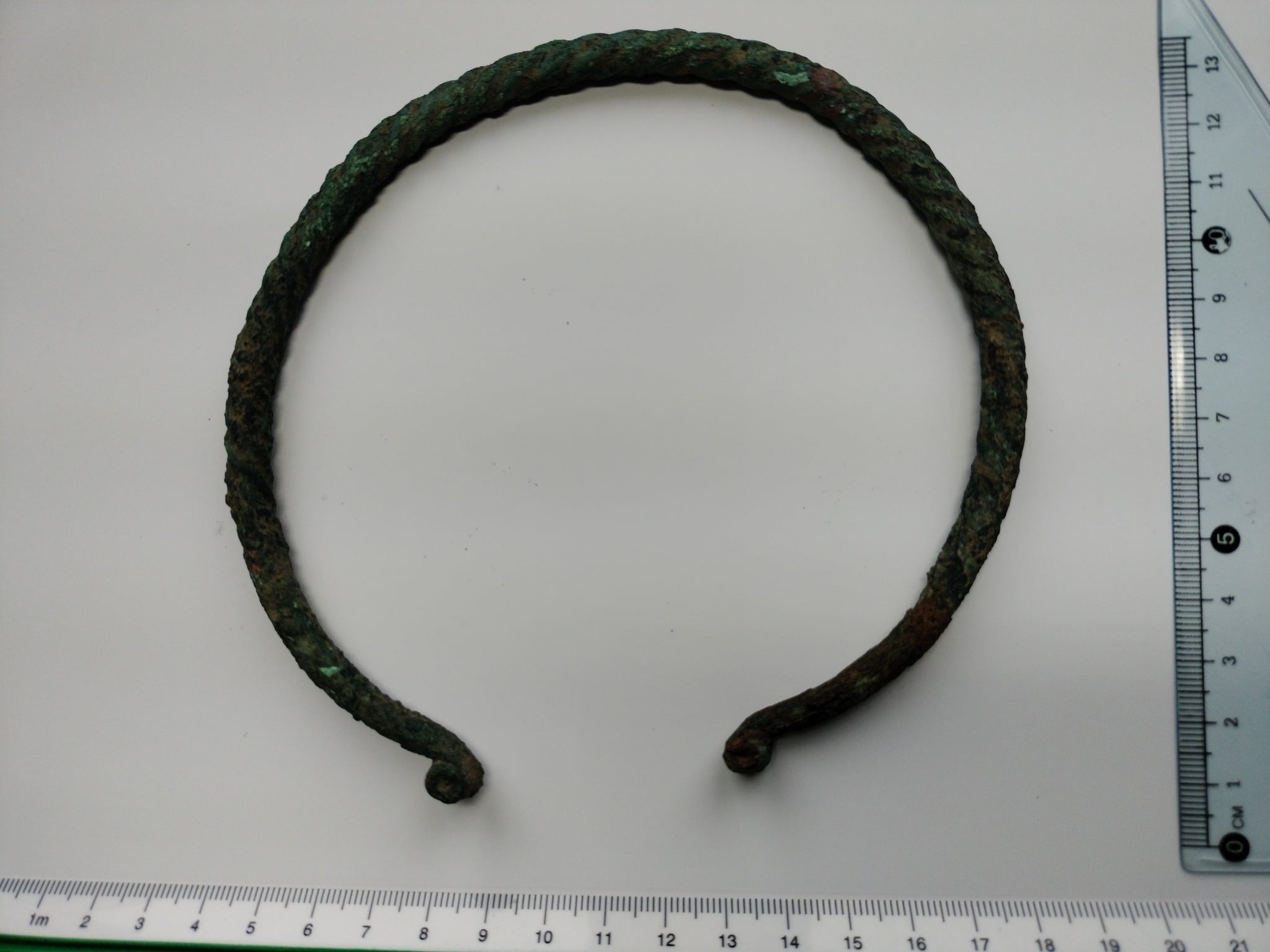Je to nádhera, když něco takového padne. Nákrčníky jsem našel jenom jednou, stálo to za to :)
Detectorist discovers a rare treasure of 2,500-year-old jewels of the Lusatian culture
Categories: Nálezy nejenom s detektorem v západní Evropě
Łukasz Jabłoński was searching with his metal detector for artefacts from the First World War near Turobin, Poland, when he came across a set of Bronze Age ornaments. They date from 550 - 400 BC, the end of the Lusatian culture, even single finds of which are extremely rare in this part of Poland.
Mr. Jabłoński searched in a meadow in Czernięczyn Poduchowy near Turobin at the end of January with the permission of the Provincial Office for the Protection of Monuments in Lublin. When he detected a signal, he dug out from under a blanket of snow and unearthed thirteen bronze artefacts from about 25 cm below the ground. He immediately reported the find by telephone to the archaeological office in Zamość, together with photographs and the circumstances of the find; he handed them in the same day.
The finds were examined by Dr. Józef Niedźwiedź, Dr. Konrad Grochecki and Wiesław Koman, M.Sc. The analysis of the artefacts shows that they are ornaments of the Lusatian culture from the Hallstatt D period (ca. 550 - 400 BC). The find is all the more rare because ornaments of the Lusatian culture were very rarely found in this area and were only single objects or small fragments. These artefacts are of great importance for archaeologists, especially in the context of the analysis of the settlement of the Lusatian culture in the region and the whole Lublin region.
A distinctive artefact of the assemblage is a twisted semicircular necklace with a diameter of 13.5 cm made of thick round bronze wire 6 mm thick, both ends of which are split and twisted. Tording is a technique of wrapping the wire around its axis. Great care must be taken with bronze as it hardens during the shaping process. Therefore, the metal is repeatedly annealed during the twisting process to remove the resulting stresses and prevent possible damage.
The treasure also contained a massive needle measuring 15.5 cm in length. It was made of a 5 mm thick quadrilateral bronze wire and a large disc of spiral twisted wire 7 cm in diameter, but it lacked a point. Another needle 16,4 cm long was made of 4 mm thick wire with fine serrations on the surface. It has been preserved in its entirety with a disc of spirally twisted wire 3 cm in diameter and a decorative 'knot' 1 mm in diameter. There is an eyelet at the bottom for attaching the ornament to the garment.
Next, there is a fragmentary preserved circular decorative shield (phalera) with a diameter of 11,6 cm made of thin bronze sheet 0,5 mm thick with a curved edge. Next, two circular shafts, each 11.9 cm in diameter, made of thick bronze wire 1 cm in diameter, withpointed, blunt-ended, overlapping ends and decorated with transverse notches.
The set also included four massive decorated bracelets, 7,5 cm in diameter and 2,8 cm wide, made of a relatively thick bronze wire, 1,8 cm thick and 0,8 cm in the middle of an oval cross-section. With them are two more bracelets, 7 cm in diameter, made of flat bronze wire 1,4 cm wide and 0,5 cm thick, with clearly ground and overlapping ends. One with decoration in the form of incised herringbone and transverse lines, the other without decoration. Finally, a fragment of a decorative tubular spike, 12 cm long and 0,5 cm in diameter, with a 0,4 cm diameter hole, made of bronze sheet, approx. 1 mm thick, and decorated throughout with fluting.
The described artefacts were officially handed over to the Provincial Museum in Biłgoraj, where the treasure is now being conserved and studied. The site of the discovery has been kept secret until now, and archaeologists are still investigating it. In recent days, probing excavations and searches of the site have been carried out using metal detectors. The results of this action will be published after their evaluation.
Roman Němec
Sources: wkz.lublin.pl, heritagedaily.com, tvn24.pl








The article is included in categories:
- Archive of articles > Archaeology > Finds and rescue research abroad > Nálezy nejenom s detektorem v západní Evropě
Post
Lužická kultura, lužický kulturní komplex či kultura lužických popelnicových polí je archeologická kultura doby bronzové a železné, jež byla rozšířena ve střední Evropě od 14. století př. n. l. do 4. století př. n. l. a náležela do širší skupiny kultur popelnicových polí, které od mladší doby bronzové sídlily ve velké části Evropy.
Hlava mi to celkem nebere. Měl by se v tom udělat pořádek. Dle nakoukaných věcí a v letopočtu krista cca 1500 p.n.l.
Dle mého názoru se nedá věřit letopočtům nálezů cca do r. 1300-1500. Zdá se mi, že každá země si to stále řadí trošku podle svého.
Ale k zamyšlení, jestli by Polskej letopočet by neseděl lépe.









